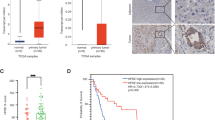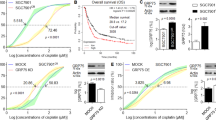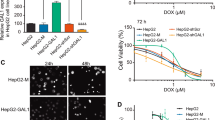Abstract
Elevated expression of the heparan sulphate proteoglycan glypican-3 (GPC3) was found on mRNA and protein levels in the atypical multidrug-resistant gastric carcinoma cell line EPG85-257RNOV, which was established by in vitro selection against mitoxantrone. In order to elucidate a putative role of GPC3 in the drug-resistant phenotype, the mitoxantrone-resistant cell line EPG85-257RNOV was transfected with an expression vector construct carrying an anti-GPC3 hammerhead ribozyme. It could be demonstrated that in anti-GPC3 ribozyme-transfected cell clones, the GPC3-specific mRNA and corresponding protein expression levels were decreased to levels that are similar to those observed in nonresistant, parental cells. The anti-GPC3 ribozyme-containing clones reduced the mitoxantrone resistance level up to 21% of the original resistance and the crossresistance against etoposide to 33% of the original value. This reversal of drug resistance was accompanied by an increased cellular mitoxantrone accumulation in the anti-GPC3 ribozyme-expressing cells. In conclusion, it was verified that GPC3 is involved in the cellular protection against mitoxantrone in the atypical multidrug-resistant gastric carcinoma cell line EPG85-257RNOV.
This is a preview of subscription content, access via your institution
Access options
Subscribe to this journal
Receive 50 print issues and online access
$259.00 per year
only $5.18 per issue
Buy this article
- Purchase on Springer Link
- Instant access to full article PDF
Prices may be subject to local taxes which are calculated during checkout









Similar content being viewed by others
References
Al-Haideri M, Goldberg IJ, Galeano NF, Gleeson A, Vogel T, Gorecki M, Sturley SL and Deckelbaum RJ . (1997). Biochemistry, 36, 12766–12772.
Bernfield M, Gotte M, Park PW, Reizes O, Fitzgerald ML, Lincecum J and Zako M . (1999). Annu. Rev. Biochem., 68, 729–777.
Boyd AP, Sory MP, Iriarte M and Cornelis GR . (1998). Mol. Microbiol., 27, 425–436.
David G . (1993). FASEB J., 7, 1023–1030.
Dietel M, Arps H, Lage H and Niendorf A . (1990). Cancer Res., 50, 6100–6106.
Doyle LA, Yang W, Abruzzo LV, Krogmann T, Gao Y, Rishi AK and Ross DD . (1998). Proc. Natl. Acad. Sci. USA, 95, 15665–15670.
Eggenschwiler J, Ludwig T, Fisher P, Leighton PA, Tilghman SM and Efstratiadis A . (1997). Genes Dev., 11, 3128–3142.
Filmus J, Church JG and Buick RN . (1988). Mol. Cell. Biol., 8, 4243–4249.
Filmus J, Shi W, Wong ZM and Wong MJ . (1995). Biochem. J., 311, 561–565.
Filmus J and Selleck SB . (2001). J. Clin. Invest., 108, 497–501.
Gonzalez AD, Kaya M, Shi W, Song H, Testa JR, Penn LZ and Filmus J . (1998). J. Cell Biol., 141, 1407–1414.
Gorczyca W, Gong J, Ardelt B, Traganos F and Darzynkiewicz Z . (1993). Cancer Res., 53, 3186–3192.
Gottesman MM, Fojo T and Bates SE . (2002). Nat. Rev. Cancer, 2, 48–58.
Haseloff J and Gerlach W . (1988). Nature, 334, 585–591.
Hsu HC, Cheng W and Lai PL . (1997). Cancer Res., 57, 5179–5184.
Hughes-Benzie RM, Pilia G, Xuan JY, Hunter AG, Chen E, Golabi M, Hurst JA, Kobori J, Marymee K, Pagon RA, Punnett HH, Schelley S, Tolmie JL, Wohlferd MM, Grossman T, Schlessinger D and MacKenzie AE . (1996). Am. J. Med. Genet., 66, 227–234.
Hyafil F, Vergely C, Du-Vignaud P and Grand-Perret T . (1993). Cancer Res., 53, 4595–4602.
Jackson SM, Nakato H, Sugiura M, Jannuzi A, Oakes R, Kaluza V, Golden C and Selleck SB . (1997). Development, 124, 4113–4120.
Kellner U, Hutchinson L, Seidel A, Lage H, Danks MK, Dietel M and Kaufmann SH . (1997). Int. J. Cancer, 71, 817–824.
Kowalski P, Stein U, Scheffer GL and Lage H . (2002). Cancer Gene Ther., 9, 579–586.
Lage H and Dietel M . (1997). Gene, 188, 151–156.
Lage H, Dietel M, Fröschle G and Reymann A . (1998). Int. J. Clin. Pharmacol. Ther., 36, 58–60.
Lage H and Dietel M . (2000). Lancet Oncol., 1, 169–175.
Lage H, Helmbach H, Dietel M and Schadendorf D . (2000). Br. J. Cancer, 82, 488–491.
Lage H, Helmbach H, Grottke C, Dietel M and Schadendorf D . (2001a). FEBS Lett., 494, 54–59.
Lage H, Perlitz C, Abele R, Tampé R, Dietel M, Schadendorf D and Sinha P . (2001b). FEBS Lett., 503, 179–184.
Lage H and Dietel M . (2002). J. Cancer Res. Clin. Oncol., 128, 349–357.
Lage H . (2003). Int. J. Antimicrob. Agents, 22, 188–199.
Lin H, Huber R, Schlessinger D and Morin PJ . (1999). Cancer Res., 59, 807–810.
Midorikawa Y, Ishikawa S, Iwanari H, Imamura T, Sakamoto H, Miyazono K, Kodama T, Makuuchi M and Aburatani H . (2002). Int. J. Cancer, 103, 455–465.
Mulder M and Terwel D . (1998). Haemostasis, 28, 174–194.
Murthy SS, Shen T, De Rienzo A, Lee WC, Ferriola PC, Jhanwar SC, Mossman BT, Filmus J and Testa JR . (2000). Oncogene, 19, 410–416.
Olofsson AM, Vestberg M, Herwald H, Rygaard J, David G, Arfors KE, Linde V, Flodgaard H, Dedio J, Muller-Esterl W and Lundgren-Akerlund E . (1999). J. Clin. Invest., 104, 885–894.
Perrimon N and Bernfield M . (2000). Nature, 404, 725–728.
Pilia G, Hughes-Benzie RM, MacKenzie A, Baybayan P, Chen EY, Huber R, Neri G, Cao A, Forabosco A and Schlessinger D . (1996). Nat. Genet., 12, 241–247.
Ross DD, Yang W, Abruzzo LV, Dalton WS, Schneider E, Lage H, Dietel M, Greenberger L, Cole SP and Doyle LA . (1999). J. Natl. Cancer Inst., 91, 429–433.
Ruffner DE, Stormo GD and Uhlenbeck OC . (1990). Biochemistry, 29, 10695–10702.
Saikali Z and Sinnett D . (2000). Int. J. Cancer, 89, 418–422.
Skehan P, Storeng R, Scudiero D, Monks A, McMahon J, Vistica D, Warren JT, Bokesch H, Kenney S and Boyd MR . (1990). J. Natl. Cancer Inst., 82, 1107–1112.
Song HH, Shi W and Filmus J . (1997). J. Biol. Chem., 272, 7574–7577.
Steinfeld R, Van Den Berghe H and David G . (1996). J. Cell Biol., 133, 405–416.
Tsai-Pflugfelder M, Liu LF, Liu AA, Tewey KM, Whang-Peng J, Knutsen T, Huebner K, Croce CM and Wang JC . (1988). Proc. Natl. Acad. Sci. USA, 85, 7177–7181.
Tsuda M, Kamimura K, Nakato H, Archer M, Staatz W, Fox B, Humphrey M, Olson S, Futch T, Kaluza V, Siegfried E, Stam L and Selleck SB . (1999). Nature, 400, 276–280.
Walker PR, Smith C, Youdale T, Leblanc J, Whitfield JF and Sikorska M . (1991). Cancer Res., 51, 1078–1085.
Wells MJ and Blajchman MA . (1998). J. Biol. Chem., 273, 23440–23447.
Wichert A, Holm PS, Dietel M and Lage H . (1999). Cancer Gene Ther., 6, 263–270.
Xiang YY, Ladeda V and Filmus J . (2001). Oncogene, 20, 7408–7412.
Acknowledgements
This work was supported by a grant from the Deutsche Krebshilfe (10-1313-La 3). We thank Yutaka Midorikawa, Hiroyuki Aburatani and Hiroko Iwanari for providing us with the anti-GPC3 mAb K6534.
Author information
Authors and Affiliations
Corresponding author
Rights and permissions
About this article
Cite this article
Wichert, A., Stege, A., Midorikawa, Y. et al. Glypican-3 is involved in cellular protection against mitoxantrone in gastric carcinoma cells. Oncogene 23, 945–955 (2004). https://doi.org/10.1038/sj.onc.1207237
Received:
Revised:
Accepted:
Published:
Issue Date:
DOI: https://doi.org/10.1038/sj.onc.1207237
Keywords
This article is cited by
-
Immunotoxin targeting glypican-3 regresses liver cancer via dual inhibition of Wnt signalling and protein synthesis
Nature Communications (2015)
-
Chitosan-Alginate Scaffold Culture System for Hepatocellular Carcinoma Increases Malignancy and Drug Resistance
Pharmaceutical Research (2010)
-
Taxol-resistance-associated gene-3 (TRAG-3/CSAG2) expression is predictive for clinical outcome in ovarian carcinoma patients
Virchows Archiv (2007)
-
Stable and complete overcoming of MDR1/P-glycoprotein-mediated multidrug resistance in human gastric carcinoma cells by RNA interference
Cancer Gene Therapy (2004)



